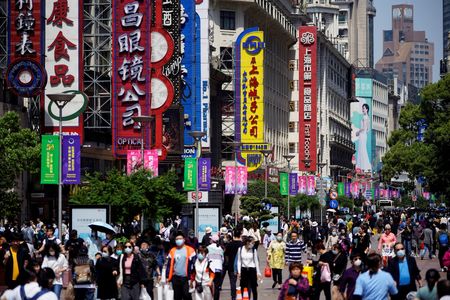BEIJING (Reuters) – China’s factory gate prices for October dropped for the first time since December 2020, and consumer inflation moderated, underlining faltering domestic demand as strict COVID curbs, a property slump and global recession risks hammered the economy.
Analysts say the struggles for businesses and consumers both at home and abroad will heap deflationary pressure on China over coming months, with aggressive global interest rate increases and the Ukraine war adding to Beijing’s challenge.
The producer price index (PPI) fell 1.3% year-on-year, reversing from a 0.9% gain a month earlier, National Bureau of Statistics (NBS) data showed on Wednesday, and compared with a forecast of a 1.5% contraction in a Reuters poll.
The consumer inflation also moderated from a 29-month high in September, and underlying price pressures remained much more modest with core inflation rising 0.6% in October, unchanged from September.
“Adverse factors like weak domestic demand and softening export will make China wary of a slide into deflation, signalled by its moderate core-CPI reading of below 1.5% growth for more than two years,” said Bruce Pang, chief economist and head of research at Jones Lang Lasalle Inc.
The deflationary impulse in the producer price gauge partly reflected the sharply higher year-ago levels and falling commodity prices, according to an accompanying NBS statement.
Prices in coal mining and washing industry were down 16.5%, deepening from a 2.7% drop in the previous month, while those in ferrous metal smelting and rolling processing slumped 21.1% after declining 18.0% in September.
The world’s second-largest economy has been hobbled this year by a recurrence of COVID-19 outbreaks, forcing authorities to implement strict anti-virus curbs in a blow to factory and consumer activity.
China’s trade engine has also taken a hit, with exports and imports shrinking in October, and economists are warning of further weakness over the coming quarters due to pressure at home and global recession risks.
“The sharp divergence between PPI inflation in China and other industrial countries means China may be gaining some competitive advantage in manufacturing that could help bolster China’s exports,” Nomura analysts said in a note to clients.
“However, the worsening of global growth is denting external demand.”
GRAPHIC: China’s October PPI turns negative China’s October PPI turns negative (https://graphics.reuters.com/CHINA-ECONOMY/INFLATION/dwvkdgwklpm/chart.png)
POLICY CHALLENGE
The consumer price index climbed 2.1% from a year earlier, easing from a 29-month high of a 2.8% increase in September, mainly driven by falling food prices. It was also slower than the 2.4% forecast by analysts.
Food prices rose 7.0% in annual terms, slowing from 8.8% rise in the previous month, with fresh vegetable prices off 8.1% from a 12.1% rise in September.
However, Pork prices – a key driver of the CPI – rose 51.8% year-on-year in October, faster than 36% growth in September.
Almost three years into the pandemic, China has pledged to press on with its strict COVID-19 containment strategy. Analysts say policymakers will be cautious in easing monetary policy for fear of capital flight amid sweeping global interest rate hikes, led by the Federal Reserve.
China’s yuan currency has already been pummelled this year by the global tightening trend and a buoyant U.S. dollar, effectively crimping headroom for any sizable policy action by the People’s Bank of China.
“The upshot is that inflation is unlikely to become a major policy constraint in China,” said Julian Evans-Pritchard, senior China economist at Capital Economics.
“That said, there are currently other barriers to monetary easing, such as the PBOC’s efforts to slow the renminbi’s depreciation against the U.S. dollar.”
The International Monetary Fund last month said it expects China’s growth to slow to 3.2% this year, a 1.2-point downgrade from its April projection, on expectations of a gradual lift of strict COVID-19 curbs next year but no quick resolution to the real estate crisis.
(Reporting by Liangping Gao and Liz Lee; Editing by Shri Navaratnam)

